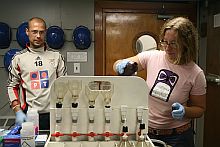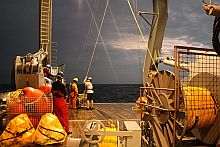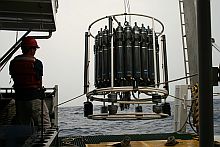Going BATS in Bermuda
|
- Dr Juliet Hermes, Manager, SAEON Egagasini Node
Thanks to a fellowship from the Partnership for Observation of the Global Oceans (POGO) and the Scientific Committee on Oceanic Research (SCOR) I had the opportunity to visit the Bermuda Institute for Ocean Sciences (BIOS) with the view to receive training in integrated, multi-disciplinary oceanography, hence improving my understanding of biological and chemical oceanography and interaction with physics.
I was also invited by BIOS to lecture a module of their 10-month course at Bermuda on Observational Oceanography as part of the Nippon Foundation-POGO Centre of Excellence (CofE) in Observational Oceanography.
At BIOS I was also able to spend time at sea, training in technical aspects, which improved my understanding of how the data is collected, stored and disseminated. Spending time in Bermuda allowed me to learn from the experiences of the Institute with the longest running fixed-point time series in the ocean and to develop international networks with many of the scientists based there.
The aim of the POGO-SCOR fellowship was for me to receive training (at sea) in a variety of different oceanographic equipment, enable me to expand my understanding of the different disciplines of oceanography (e.g. chemical and biological), as well as to learn about the long-term time-series that is maintained at BIOS and how the data is processed and analysed. In return, the intention was for me to to take this knowledge (and new networks) home and use these in my role of setting up long-term marine-offshore monitoring in South Africa.
The first few days in Bermuda were spent learning more about the BIOS station operations. I met with the key physical oceanographer and discussed the way in which the physical oceanography is measured, how the data is handled and the results that have been achieved from the long-term time-series - in particular the different anthropogenic and natural variability that has been identified. I also read up about the different results that have been achieved by BIOS, and interacted with some of the scientists that have achieved these results. I put these together in a presentation for the new POGO students.
The second week was spent at sea. This involved taking measurements at the "Hydrostation S" as well as BATS (Bermuda Atlantic Time Series). During the cruise we were able to spend time investigating an eddy which had been present in the region for a while. It was really exciting to be able to track and investigate the eddy, particularly since eddies form a large part of the variability in the oceans around South Africa.
Measuring the ocean parameters
Throughout the cruise I was able to gain hands-on experience of measuring many different, key oceanographic parameters, which also meant spending time in the laboratories on board the ship. It was very informative to work with the marine technicians and scientists on board, who were able to explain the different processes and standards involved in measuring the physical, chemical and biological ocean parameters.
My main focus was to better understand different disciplines of oceanography (aside from physical) and the importance of monitoring these. This was more than achieved during the cruise, where I learnt about the importance of parameters such as Berylium-7, carbon (and other dissolved gases), chlorophyll and dissolved organic matter, dimethyl sulphide, phytoplankton and bio-optics. To measure these I was given hands-on experience using instruments including the CTD (conductivity, temperature and depth), the Spectral Profiling Multi-channel Radiometer, sediment traps, phytoplankton nets, Winkler titration and various filtering techniques.
During the cruise I was also given the opportunity of being the direct link between the POGO students and the chief scientist. This increased my motivation to better understand the processes and to present them to the students.
On returning from sea, I had a week to attend to work commitments in South Africa, as well as to work on lectures for the POGO students the following week. This was useful as the lectures involved manipulating some of the BIOS data. I was also able to sit in on some of the lectures about ecological modelling.
The third week I spent lecturing the students in physical oceanography and data manipulation, in particular looking at the data from BIOS. During this time I was also able to learn from each of the students about the work they are doing in their own countries (most of which was non-physical oceanography) and to build up strong networks with them. We also had the opportunity to go to sea again for 24 hours to return to the "Hydrostation S". Again I was given the opportunity of organising the POGO students and getting hands-on experience with regards to gathering data.
The fourth week was spent talking directly to key scientists at BIOS, and discussing their research. I was able to build some very useful connections during this week and it gave me the opportunity to learn from scientists experienced in long-term monitoring.
The latter part of the week and the weekend/following week I continued to lecture the POGO students and we looked at using various programs to analyse the BATS data. Discussing the pros and cons of a long-term time series focusing on just one point in the ocean with the physical oceanographer at BIOS was extremely useful. Learning from the years of experience that is evident at BIOS is invaluable for the goals we are trying to achieve in South Africa.
Moving forward with SAEON's marine offshore component
The hands-on experience will certainly prove useful when the opportunity arises for me to go to sea. This, combined with talking to the marine technicians and the research scientists gave me a much better understanding of the many facets of oceanography and how they interface. The overall experience will certainly help me move forward with the marine offshore component of the SAEON science plan and has enthused and educated me in terms of multi-disciplinary oceanography.
Through discussions with the director of BIOS, Tony Knap and the education director, Gerry Plumely, I was able to learn about what it takes to set up such an institute, amongst other things, and this was very inspiring for me.
The lectures that I wrote for the POGO students, as well as the feedback I received, will be useful for training students at my home institute; I will likely be giving a similar course to the Department of Environmental Affairs and Tourism's Marine and Coastal Management before the end of the year.
This turned out to be an unusual fellowship programme, in that I was able to achieve more than I had anticipated. It was a fantastic opportunity to build up connections with people from first-world countries, but to be able to share these experiences with other people from developing countries added tremendously to the experience.













